Neural networks are now established as statistical tools
that give significant advantages over conventional methods when used in
appropriate applications.1 The artificial networks of a few thousand
neurons that can now be built fall far short the human brain, which has about
1010 neurons and 1014 connections. They do, however, have the
advantage of electronic speeds
compared with the brain's much slower chemical processing. The ESPRIT project
ANNIE, led by AEA Technology, on industrial applications of neural
networks2 succeeded in comparing neural networks with the
best state of the art conventional methods. Applications considered were defect classification in
pattern recognition, robotic collision
avoidance and optimization of aircraft crew scheduling. A generic conclusion
was that although in many applications neural networks gave no significant improvement in
performance, they could dramatically enhance speed. In
the classification of weld defect from ultrasonic data, for example
(considered within the project), a neural network gave essentially the
same performance as a classical adaptive receptive field classifier trained on identical examples, but
was fast enough to be able to operate on-line.3
A more fundamental advantage over most conventional methods,
however, is the ability of neural networks to perform non-linear
mappings of arbitrary complexity. The essence of neural network methods is the
single neuron, Fig. 1, which delivers an output that is a non-linear function of the inputs received from
other neurons, Each neuron may be considered as a
low-level feature detector that seeks out patterns it has been trained to
recognize in the input data.A second layer of
neurons then takes these low-level features as its input data, and generates
the high-level features that are needed for
pattern classification or process control. In the example in Fig. 1, the

Fig.1. A single neuron and its mathematical model
dendrites of the ith neuron accept signals aj
from the axons of other neurons j. The synapses modify the input signal
in a way modelled by the weight wij.The output signal ai
depends on a sigmoid function f(x) of the weighted sum of inputs less
the threshold wi0, divided by an equivalent
thermal energy kT. The inset shows the mathematical form of the sigmoid
function simulated by the network hardware. It
is the presence of the second set of non-linear elements that has made the three-layer
MLP the dominant method in
current neural network practice. Its static nature (e.g. in this application it
makes no attempt to follow the time dependence of the mapping) may mean, however, that it will be
superseded by dynamic recurrent networks. The MLP illustrated in Fig. 2 has the three-layer
structure implemented in hardware on COMPASS-D. Neurons in each layer of the MLP are fully
connected to neurons in the layers above and below, but not within the same
layer or across layers.
Its function is to perform a non-linear mapping from the input to the output
space. On COMPASS-D at present, 32 input variables, which represent various magnetic diagnostic signals,
are mapped into a two-dimensional space that defines the top of the plasma and its elongation x. Because arbitrary
amplitudes are possible for the weights the input variables may have all sorts
of different magnitudes, units and functions. They may equally be control
currents in kilo-amps, or soft X-ray amplitudes. The neural network is able to
fuse such diverse data to make its 'decision' just as the human operator is
able to assimilate information from the many displays in the control room.
The ANNIE project concluded that neural networks could give
dramatic benefits in the speed of operation after training. The training is a good
one. Contemporary management recognizes that training is an investment,
even if it requires many hours of dedicated effort, both
from the teacher (who selects and appropriately presents the
material to be learnt) and from the student. To train a neural network,
training data must be collected or simulated and transformed
into such a form that the network is not swamped with or denied information.
With each training example (point on the input mapping), must go the corresponding target
(point on the output mapping). This may be a
classification, such as a 'crack' defect, or a parameter, such as the elongation
of a plasma. During training the examples are
repeatedly presented to the network together with the targets, and the weights
of the network adjusted iteratively until
the match between the network outputs and the targets is as good as possible.
This is a relatively long process, a few
hours on a PC for the COMPASS-D network.
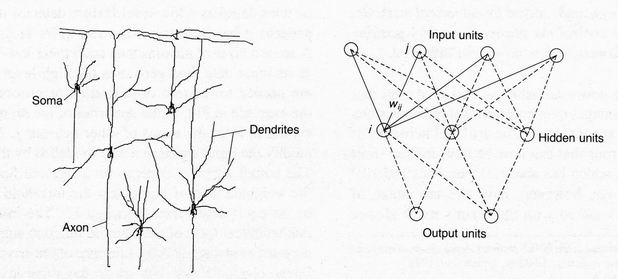
Fig.2 Multilayer perceptron neural network compared
with a portion of cortex.
Outside the research environment, however, it is a one-off
task, and does not have to be repeated unless the training data or targets are
changed. The trained network, like the trained human, must be considered a
valuable asset to any business. The network trained to classify defects from
ultrasonic signals, for example, can truly be considered to encapsulate at
least some aspects of the experience of a trained inspector. The trained
network for tokamak control encapsulates some four box-files of 'shots', each
detailing the shape of the plasma for particular sets of diagnostic
inputs.
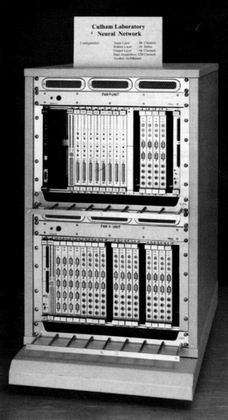
Fig. 3. The hardware implementation of an MLP neural network
in use on the COMPASS-D tokamak at UKAEA Culham Laboratory
Once the long training stage is complete, operation of the
network in its 'feed forward' mode - where inputs are presented to the network
and an output is calculated - can be very fast. The phrase 'parallel
distributed processing' describes the key to the speed of operation. Each
neuron in any one layer can operate independently from any other in evaluating
its output sum. By using independent analogue or digital processors, the
necessary calculations can be performed simultaneously in a time determined by the
band width of the analogue circuits or the cycle time of the processors. The
analogue circuits used in the UKAEA tokamak control application at Culham,
shown in Fig. 3, have a band width of 100 kHz and are able to evaluate their
outputs in ~10 ms. Such a result is not
currently achievable by any conventional digital method. The three types of
card needed for a 32 normalized
input, 15 hidden unit, 2 output network now sit within a single crate.
Most of the applications of neural networks remain implemented
as software simulations. The Applied Neuro-computing centre at AEA Technology,
Harwell, has developed several such applications to the stage of commercial
software products.4 The Centre is now able to undertake consultancy
and development contracts involving
application of neural networks to a variety of problems, including pattern
recognition, elastic matching, process control, sound assessment and data
mining.
2. The problem of tokamak control
Fusion power offers environmental and safety advantages over
any known alternative power source.5 The world is cooperating in the design of a
demonstration fusion reactor, 'ITER', with a sustained burning plasma, to begin
operating around 2010. Technical problems remain, such as how to
control the position and shape of the plasma boundary within the ITER containment vessel to within a
centimetre or so. Facilities such as
the COMPASS-D tokamak at Culham are test beds on which to confirm the
feasibility of novel control methods which might meet this specification.
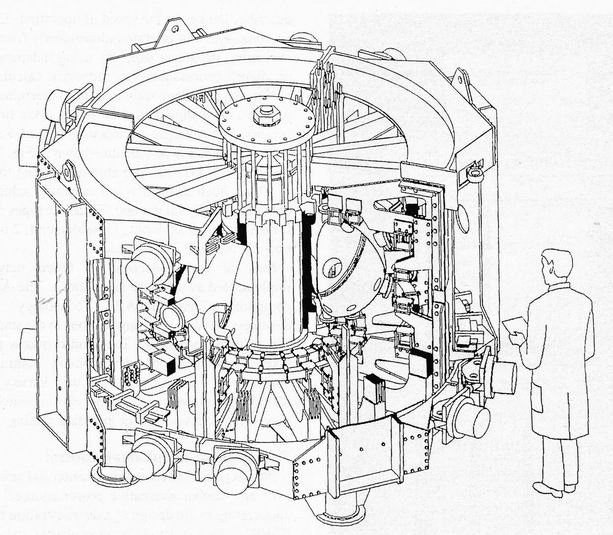
Fig. 4. The COMPASS-D tokamak
Figure 4 shows COMPASS-D and Fig. 5 illustrates its neural network control
circuit. The plasma lies in a toroidal vacuum vessel with a D-shaped cross
section. Powerful currents around the centre column and torus act as the
primary coil of a transformer whose secondary coitis the plasma itself. Within
the vacuum vessel, isotopes of hydrogen at low pressure are ionized and heated
to form the plasma. One key to obtaining plasmas with the necessary densities,
temperatures and energy confinement times is the shaping and positional control
of the plasma. COMPASS-D has a series of special coils and fast-amplifier
circuits for this purpose. These are
programmed to elongate the plasma from its initial circular shape to a complex
shape lying in a precisely calculated position within the vessel.
Various diagnostic systems are used to
determine the plasma shape and positional parameters at any instant. Some 32
magnetic coils selected from hundreds placed around the vessel measure the
magnetic fields and fluxes produced by the plasma. The outputs from the coils
are used as inputs to the present system. It is hoped to use in the future
additional inputs from soft X-ray emission profiles. The
existing conventional control system uses linear combinations
of selected inputs to drive simple feedback loops in the radial
and vertical directions. The linear nature of these methods, however, means that they cannot be
expected to work accurately over the wide range of plasma shapes
encountered,even in a single
shot.
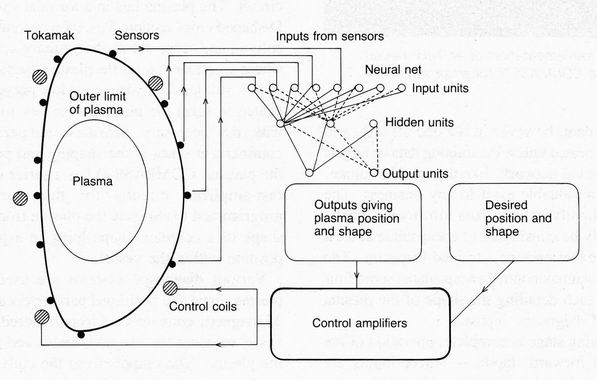
Fig.5. The neural network control system
implemented on the COMPASS-D tokamak
In contrast, the neural network is able to predict selected plasma
parameters precisely over the whole range of shapes within the training
database.6 The training database has been slowly built up by
choosing values for the control and shaping currents and for the plasma current
density functions. These are entered into a numerical solution of the Grad-Shafranov equation to find the
corresponding equilibrium plasma shape. Many of these simulated example shots
have been selected randomly from configurations that give rise to possible
plasma equilibria. Others have been
designed as small random perturbations from actual plasma shapes occurring at
selected times throughout the shot. A database of over 2000 shots is now
available, defining the detailed
mapping between the magnetic inputs and the plasma shape parameters.
3. Training the neural network
The use of standard back-propagation and conjugate gradient
descent methods1 makes this a straightforward task. There are many
variables to optimize but a well-defined quality function to minimize - the
least squares differences between the targets and the network outputs. A key
variable is the number of hidden units. This defines the total number of
adjustable parameters in the network and so the degree of detail by which the
mapping can be described. Figure 6 shows the learning curve for networks with
different numbers of hidden units. The residual fit to the training data
continually reduces with iteration number and with hidden unit number. The test
performance shown in Fig. 7, however, shows a minimum residual at around 15
hidden units, which was therefore chosen for the size finally used in the
hardware. The larger networks fitted the training data better but 'over-fitted'
and failed to generalize accurately when presented with test data.

Fig. 6. Learning curve for 15 input, 3 output networks
A second key parameter is the number of outputs. Figure 8
shows the test performance as a function of the number of outputs, showing, as
expected, a steady degradation with increasing number of outputs. The chosen
network had just two outputs while a network of eight outputs gives only one
third the accuracy. An eight output network is capable of giving a good
parametric description of the plasma boundary and will shortly be used to drive
a visual display. The principal output desired by the COMPASS-D operating
team in the near-term was the height of
the upper plasma boundary at the radial position of a reciprocating Langmuir
probe, which had recently been installed. Figure 9 shows the training and test
performance for the network output compared with the actual boundary height
when using the same set of trained weights and input variables. The root mean
square difference in training is 25 mm and in test is just 30 mm.
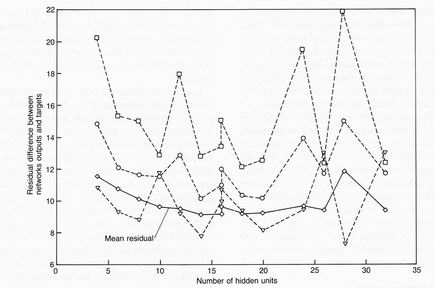
Fig. 7.Test performance using example shots not used in training. Dashed lines:
individual outputs
The weights of the trained software network can be
down-loaded directly to the VME bus controlling the hardware network. The network also receives an input
giving the plasma current, which is used to normalize electronically the
network inputs to the constant plasma current used in the training data. The
performance of the network was tested by a simulation program in which both the
final outputs, and the intermediate inputs and outputs to each sigmoid, could
be compared with a simulation based on the recorded input variables as a
function of time. The hardware reproduces the standard sigmoid neural transfer
function
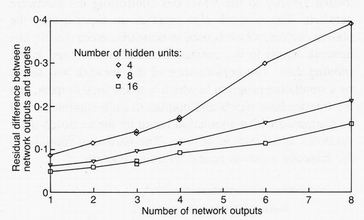
Fig. 8.Test performance as a function of the
number of outputs and number of hidden units
f(x) = b[l/{l + exp(-ax + g)}]
and simulation is able to take into account, if required,
the measured small deviations of the sigmoid amplitude b and
exponent a from their design
values, and the measured offsets to each sigmoid. Figure 9 shows an example of
the actual and simulated output representing the upper plasma boundary height at
the radius of the reciprocating probe.
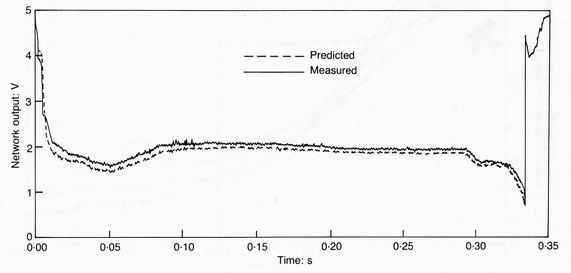
Fig. 9.Simulation of the hardware neural network
3. On-line control of the plasma boundary
When in operation, the `plasma top' output is wired to
replace the existing linear height estimator. Its value is compared with a
programmed height waveform for the shot and the difference is fed to a circuit
that drives the fast amplifier, which controls the vertical position.
Figure 10 shows the probe height desired output (Zref)
compared with the network
output (Zprobe). The programmed vertical position was given a
20mm ramped change at 140 ms. The
network output
is seen to reproduce this change precisely. The sharpness of the edges of the
ramp demonstrates the sub-millisecond
response time of the network. The true performance of the network can be
assessed from television pictures of the
visible light emitted by the plasma. The images in Fig. 11 show the top of the
plasma directly and readily show the
shift at around 140 ms. In a second
shot the plasma elongation was programmed to change while the upper plasma
boundary was maintained at a constant position. Other shots have demonstrated
the increase of elongation of the plasma
under programmed control.
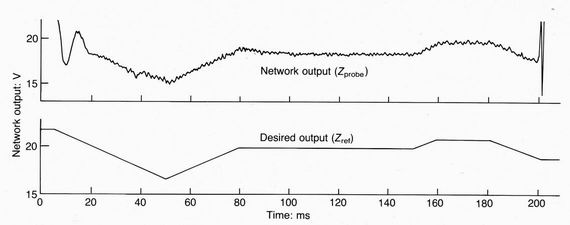
Fig. 10.The network output of plasma height compared with
desired profile
4. Conclusions
This project shows that sub-millisecond control is possible
using a hard-wired neural network even for this most complex of problems. The
MLP network is shown to be able to perform the required mapping of 32 magnetic
inputs to plasma height with an acceptable error of around 3mm. The hardware
implementation of the chosen network was able to accommodate the 15 hidden
units network suggested by software optimization. It has proved straightforward
to operate and is easily loaded with new network configurations and trained
networks, It should be possible to use the hardware developed by the Culham
team to implement similar control schemes.
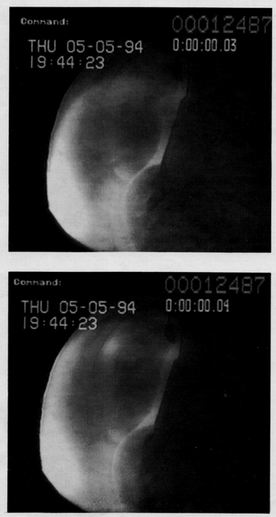
Fig. 11.Television pictures of the visible light emitted from the
plasma before and after the programmed rise in the plasma upper boundary:
images ageraged between 140-160 ms (top) and 180-200ms.
6. References
1.. RUMELHART D. E. et al.Learning internal representions by error propagation,
Parallel distributed processing. MIT Press, Cambridge. MA, 1986.
2. CROALL. I. F. and MASON J. P. (eds) Industrial applications of neural networks.
Springer Verlag. 1991.
3. WINDSOR C. G. et al. The classification of defects
from ultrasonic images: a neural network approach. Brit. J. NDT; 1993, 5, 15-22.
4. MASON I. P. et al. A novel algorithm for chromatogram matching in qualitative analysis.
J. High Res. Chromatag., 1992, 15. 539-547,
5. O'BRIAN M. and ROBINSON D. Setting the course for a commercial power plant, ATOM, 1994, 434, 32-35.
6. BISHOP C M. et al. Hardware implementation of a neural
network to control plasma position in COMPASS-D. Fusion Technol., 1993, 997-1001.

 Nucl. Energy, 34, No. 2 Apr., 85-91, 1995.
Nucl. Energy, 34, No. 2 Apr., 85-91, 1995.









